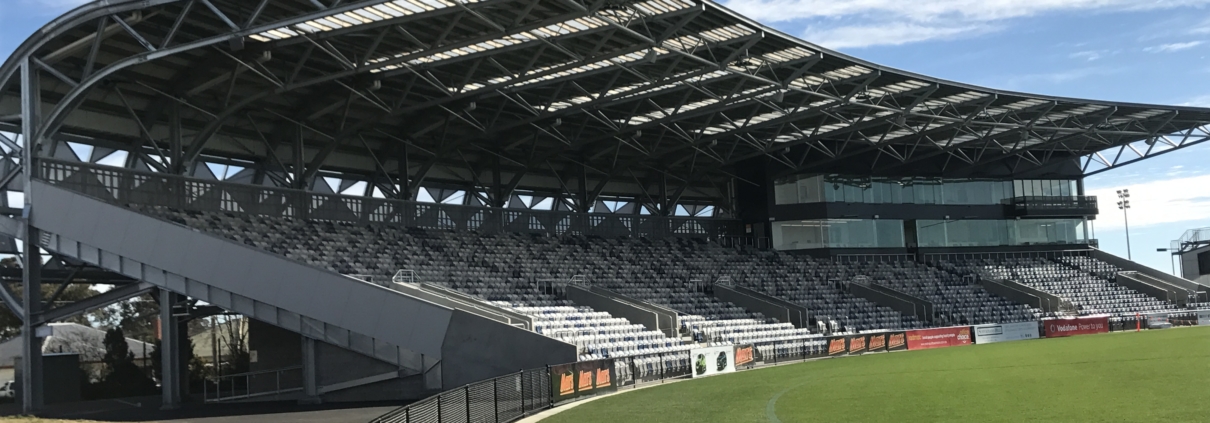Mars Stadium (previously Eureka Stadium)
Stage I of Ballarat’s Major Events Precinct redevelopment used 360 tonnes of hot dip galvanized (HDG) steel work in the upgrade of Eureka Stadium to the new Mars Stadium. The HDG coating solution provided the project cost and time efficiencies required for the new regional sports and entertainment facility, the first of its kind in the western district.
The AFL held the first match at Mars Stadium in July 2017 and has committed to more matches in 2018. The facility is expected to attract an extra 1,500 participants per year, boost visitor numbers to Ballarat by 21,000 and increase tourism spending by up to $3.6 million annually.
Project highlights
Duration: 18 months
Type: Multi-purpose stadium redevelopment
Cost: $38.5million joint venture between the State Government and City of Ballarat ($15million for Stage I Eureka Stadium upgrade completed July 2017)
Unique design
In the Western stand, a cantilever roof, constructed using galvanized steel in a truss design provides an abundance of natural light. It was designed for easy installation and is strong enough to withstand wind and earthquake loads for Ballarat. The curved arch form was created using infill frames and the seating structure to stabilise the roof load. The weight of the seating platforms work in conjunction with the structural steel supports to anchor the whole structure to the ground.
The benefits of Hot Dip Galvanizing(HDG)
The use of Hot Dip Galvanizing (HDG) (over the originally specified 3-coat paint over steel) provided a more efficient solution.
| Fast turnaround | Cost savings | Time to first maintenance |
| The lead time on delivery of galvanized steel was half that of paint over steel. | HDG delivered a cost saving of around $200,000 for the 360 tonnes of steel compared to paint over steel. | As the stadium is in a regional centre, in a C2 corrosion zone, the ‘set and forget’ value of HDG was an important long-term benefit. |
The Mars Stadium delivered incredible value with a total construction cost of $3,000 per undercover seat, compared to the industry standard of $10,000 in similar stadiums.
Overcoming challenges
Cost constraints drove many design revisions on the project. The stadium design had many over dimensional works, including 3.5 metre wide frames and trusses up to 18.5 metre long. These frames required double dipping and specialised logistics from the fabricator to Kingfield, then directly to the Ballarat site, on short lead times.
Kingfield worked closely with the fabricator Plinius in the early stages of fabrication, together making changes to the frames to simplify the galvanizing and transport processes. Further consultation on the cantilever roof design enabled suitable venting methods to be applied and single dipping of the curved roof structures.
Stakeholders
All stakeholders were committed to delivering this project on time and within budget with ongoing communication between parties. Discussions between Kingfield and Plinius about venting requirements and hanging points resulted in condensed time frames. There was also a clear understanding on when works were ready for collection from the fabricator and when galvanized product was due on site.
Project outcomes
The Mars Stadium project provides a solid example of the time and cost benefits, durability and reliability, and design flexibility of HDG. As a State and Local government funded project it is a showcase precinct for the City of Ballarat that will continue to be in the media as Stages II and III are developed.
The project was a GAA 2017 Sorel Award finalist. It also supports Kingfield Galvanizing’s recent win at the 2017 Premier’s Sustainability Awards for our low emissions, highly automated, sustainable hot dip galvanizing plant.
Project team
Architect/Designer: Peddle Thorp
Developer/Builder: Nicholson/Atelier Projects
Fabricator: Plinius Engineering
Hot Dip Galvanizer: Kingfield Galvanizing
Tonnes of Steel: 360

